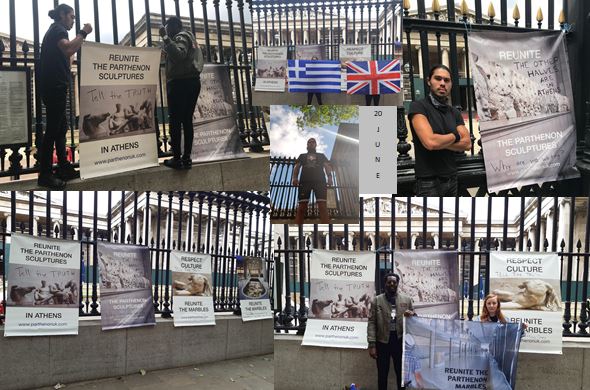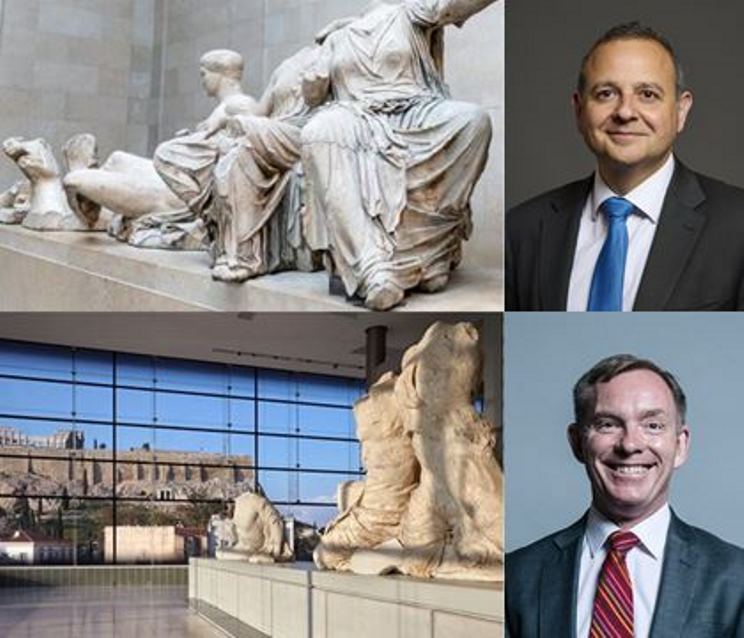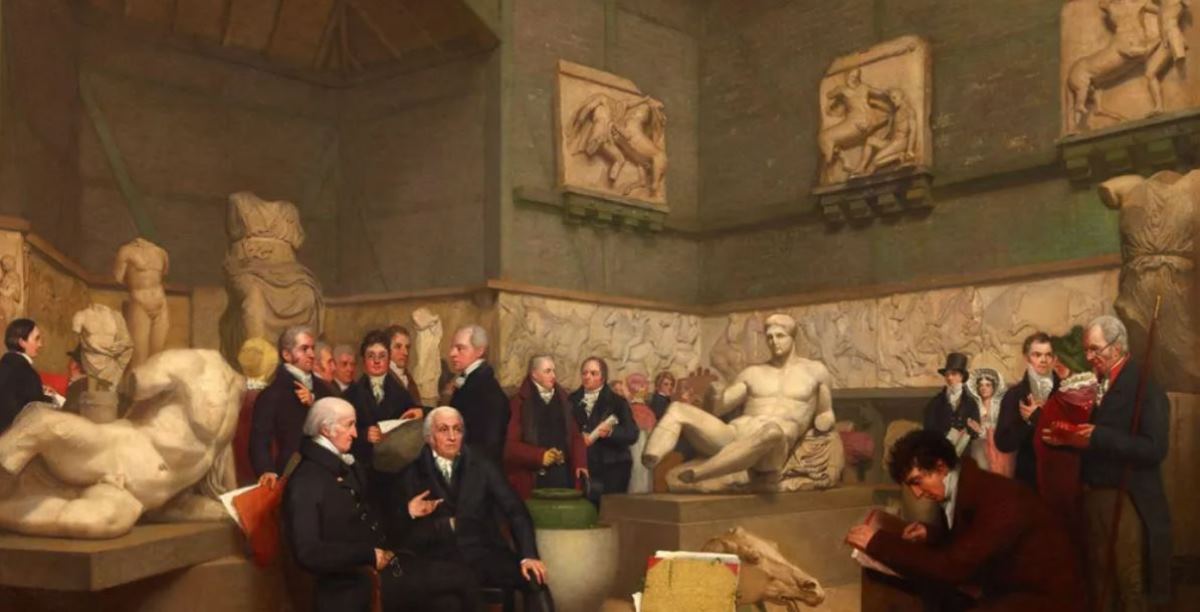On Saturday 20 June, the British Committee for the Reunification of the Parthenon Marbles (BCRPM) organised a silent protest outside the gates of the British Museum, which remains closed. The protest follows on for those held in previous years and since 2009 when the then ‘New Acropolis Museum’ in Athens was officially opened. This Saturday’s protest was held to marked the 11th anniversary of the Acropolis Museum, which post Covid19 lockdown re-opened to the public on Monday 15 June 2020.
The four large banners that were tied to the British Museum’s railings were the four original banners that hung down from the 4th Plinth in Trafalgar Square, when 19 year old student from Central St Martin’s College, Sofka Smales stood to protest, 12 September 2009, on behalf of the reunification of the Parthenon Marbles. On the following day, accompanied by Eleni Cubitt and Marlen Godwin, Sofka visited the British Museum to hand the letter she had written on a roll of wallpaper during her protest on the plinth to the then British Museum Director, Neil MacGregor.
On Saturday the London protesters, Luke, Zara and Tayo wore the 2020 Melina Mercouri t-shirts that made their debut at the 08 February 2020 BM protest. They hung the 4 posters with a few additional scribbles on them (11 years later, there was more to say!) and held the ‘Reunite the Parthenon Marbles’ flag that Professor Edith Hall held out for the first time on 22 February 2020 in the British Museum’s Room 18, the Parthenon Galleries, at the end of Natalie Haynes recital of ‘A Thousand Ships’ the voices of the women of Troy.
On Saturday, 20 June, the Acropolis Museum reduced its entrance fee and there were a number of talks and additional exhibitions for visitors to take part in, including: ‘Chisel and Memory’, ‘The lost statue of Athena Parthenon’ and ‘A walk through the Museum with an archaeologist’.
The Director of the British Museum, Dr Hartwig Fischer spoke to UK correspondent for Ta Nea, Yannis Andrtisopoulos that the Acropolis Museum and the British Museum “are complementary in their approach,” adding that the museum “looks forward to continuing our collaboration and fruitful dialogue with our colleagues at the Acropolis Museum.”
Minister of Culture and Sport for Greece, Dr Lina Mendoni commented :“ Perhaps the main argument that the British Museum has been making for years in order not to return the Parthenon Sculptures - since 1982, when Melina Mercouri raised the issue at a UNESCO Conference of Ministers - was that Greece did not have a modern museum that could house the masterpieces of Phidias. Since September 2003, when the construction work for the Acropolis Museum began, Greece has been systematically demanding the return of the Sculptures, which are on display in the British Museum, because they are products of theft. The current Greek government - like any Greek government - is not going to stop claiming the stolen sculptures, which the British Museum continues to hold illegally contrary to any moral principle.”
Conservative MP Sir Roger Gale reflected: “while I do not hold to the view that all artefacts should be returned to their country of origin it does seem to me that the Parthenon Marbles have a good home to be returned to and a facility in which they can be properly displayed in home surroundings for the benefit and enjoyment of visitors from all over the world.”
Labour MP Mary Glindon also added: “I have enjoyed several classical tours of Greece and a highlight of those tours has always been the visit to the Acropolis and the Parthenon. But it’s sad that the Parthenon Marbles are in London. While they are seen in the British Museum by many people, as many, if not more, would appreciate seeing the Marbles as part of the amazing cultural experience to be enjoyed when visiting the Parthenon and the Acropolis Museum. The Marbles belong in Athens.”
Dame Janet Suzman, Chair of the BCRPM concluded: “there’s always an anniversary to celebrate. June 16th marked the 44th year since the student uprising in Soweto that was a turning point in the downfall of the apartheid state. A global reaction to the murder of a black man in America is sweeping the world, and those same students, grown much older if they survived at all, want to honour that murder by urging “a move away from a world centred on white supremacy and violence to one centred on justice and equity”.
“That argument was taken further when last week a statue was torn down from its plinth in the city of Bristol in England and thrown into the waters of the harbour where the slave ships used to anchor. Bristol, aware too well of its past, has decided that the statue should now be placed in the city museum with a full explanation of how the trader became so rich. Visitors can then understand that the defaced bronze figure is not just a benefactor of the city but a man who grew rich on other people’s misery, by exploiting the cruellest of white supremacies - the slave trade.
“And in Greece, the end of the Ottoman Empire’s occupation will be celebrated next year. Taking over bits of the world and ruling them according to your own values is an occupation that the British know only too well; at its height that Empire ruled a third of the world. So when Lord Elgin, British ambassador to the Ottoman court, decided he wanted to send back bits of the Parthenon to adorn his house in Scotland, he didn't bother to ask the subject Greeks, he greased the palms of functionaries from Istanbul, persuaded his own king to provide a ship and made off with the glory that was Greece. They landed up in Room 18 of the British Museum and for 200 years have been one of its star attractions.
“So we need to ask the British Museum, hiding from the tsunami of anti-colonialist feeling sweeping the whole world, whether they would have the decency to provide visitors with the full story: how did these incomparable pieces of sculpture torn from the greatest building in the western world get to sit - out of context - in the grey grandeur of Room 18? Reunification of the Marbles would seem to be a move away from white British exceptionalism and a move towards a world the survivors of Soweto are desperate to see. White supremacy stole them away and a white sense of justice should see them restored. But until that time comes, as it surely must: tell the story. Let the people judge the fairness of their captivity in London. There is a museum waiting for them in Athens.”






Comments powered by CComment